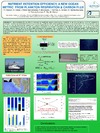Please use this identifier to cite or link to this item:
https://accedacris.ulpgc.es/jspui/handle/10553/12910
| Title: | Nutrient retention efficiency, a new ocean metric from plankton respiration and carbon flux | Authors: | Packard, Theodore T Osma, Natalia Fernández-Urruzola, Igor Maldonado-Uribe, Federico Martínez, Ico Tames-Espinosa, Mayte Romero Kutzner, Vanesa Bru, Eduardo Gómez, May |
UNESCO Clasification: | 251001 Oceanografía biológica | Issue Date: | 2015 | Abstract: | Nutrient retention efficiency (NRE) is a new metric to quantify the capacity of an ocean layer to maintain its nutrients. Conceptually, it is the remineralization of inorganic nutrients associated with respiratory CO2 production (RCO2) within an ocean layer normalized by nutrients fluxing into that layer. It can be expressed as a ratio or a percent. Operationally, below the euphotic zone, it can be calculated either as the ratio, RCO2/(carbon flux) associated with an ocean layer or the inverse of the carbon-flux transfer-efficiency through that layer. Furthermore, it is related to the maximum curvature (b) of the respiration-depth function [RCO2 = (RCO2 )0 z-b]. NRE increases when the absolute value of b increases. NRE associated with microplankton can be calculated from microplankton-ETS depth-profiles. NRE associated with zooplankton can be calculated from zooplankton-ETS depth-profiles. Conceptually total NRE equals the sum of the NREs associated with allplankton fractions. In the Peru upwelling the NRE, associated with the microplankton, displayed a minimum 40 km seaward of the upwelling center over sediments calculated to have high benthic respiration. | URI: | https://accedacris.ulpgc.es/handle/10553/12910 | Source: | 2015 Aquatic Sciences Meeting. Aquatic Sciences: Global And Regional Perspectives — North Meets South, Granada. Spain | Rights: | by-nc-nd |
| Appears in Collections: | Póster de congreso |
Page view(s)
32
checked on Jan 10, 2026
Download(s)
9
checked on Jan 10, 2026
Google ScholarTM
Check
Share
Export metadata
Items in accedaCRIS are protected by copyright, with all rights reserved, unless otherwise indicated.
